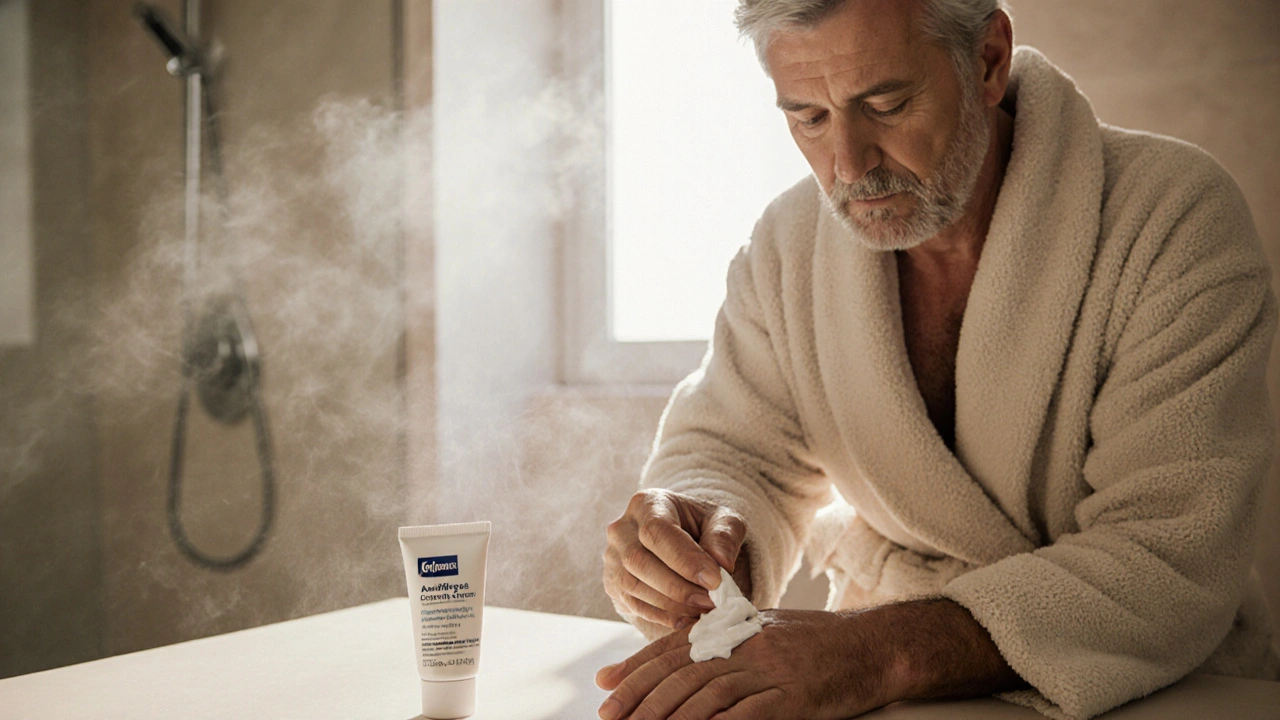Fungal Infection Identifier Quiz
Answer the questions below to identify which common fungal infection you might have.
1. Where is the affected area located?
- Between the toes or soles
- Groin, inner thighs, or buttocks
- Body, scalp, or nails
- Mouth or warm skin folds
2. What does the rash look like?
- Scaly, flaky patches
- Red ring with clear center
- Itchy, red patches
- Small pimple-like bumps
3. Are there other symptoms?
- Itching, burning, or stinging
- Swelling or pus
- No significant discomfort
- Painful or tender skin
Your Result:
Fungal infections on the skin are annoying, itchy, and sometimes embarrassing. Whether you’ve spotted a flaky patch on your foot after a hike or a red ring on your arm after a beach day, you’ve probably wondered how to stop it fast and keep it from coming back. This guide walks you through the most common culprits, simple habits that keep them at bay, and proven ways to clear them up without a pharmacy run‑around.
TL;DR
- Keep skin dry and clean - moisture is a fungus’s best friend.
- Use an over‑the‑counter antifungal cream at the first sign of itching.
- Prescribed oral meds like terbinafine are needed for stubborn or widespread cases.
- Change socks, shoes, and towels daily; disinfect shared surfaces.
- See a doctor if the infection spreads, is painful, or doesn’t improve in two weeks.
Understanding the Usual Suspects
Four fungal infections show up far more often than the rest. Knowing how each looks makes it easier to act fast.
Athlete's foot is a common skin fungus that thrives between the toes, causing itching, burning, and peeling skin. It loves warm, damp socks and communal showers. If you notice a white, scaly patch that turns red after a long run, you’re probably dealing with this one.
Jock itch is a fungal infection that targets the groin, inner thighs, and buttocks, leading to red, itchy patches. Men who sweat a lot during sports are more prone, but anyone who wears tight, non‑breathing underwear can get it.
Ringworm is a round, raised rash with a clear center that can appear on the body, scalp, or nails. Despite its name, it’s caused by a fungus, not a worm, and spreads through skin‑to‑skin contact or contaminated objects.
Candidiasis (often called a yeast infection) is a fungal overgrowth that affects moist areas like the mouth, genital region, or skin folds. Moisture, antibiotics, and high‑sugar diets can tip the balance in favor of Candida.
Prevention Strategies That Actually Work
Stopping a fungus before it lands is easier than battling it after it settles. Here are the habits that make a real difference.
- Keep skin dry: After showering or swimming, pat the feet, groin, and other folds with a clean towel. Use a hair‑dryer on a cool setting for hard‑to‑reach spots.
- Choose breathable clothing: Cotton socks and moisture‑wicking athletic wear let sweat evaporate instead of pooling.
- Rotate shoes: Give shoes at least 24hours to air out. Sprinkle a little talc inside to absorb lingering moisture.
- Don’t share personal items: Towels, razors, and nail clippers can be vectors. If you must share, disinfect with alcohol wipes first.
- Maintain good foot hygiene: Trim nails straight across, file the edges, and clean the undersides of the toes daily.
- Watch your diet: Reduce excess sugar and refined carbs; they feed yeast like Candida.

Treatment Options Overview
Most superficial fungal infections respond to topical agents, but deeper or widespread cases need a stronger approach.
Antifungal cream is a topical medication that kills or stops the growth of fungi on the skin surface. Brands like clotrimazole 1% or terbinafine 1% are available without a prescription.
Clotrimazole is an over‑the‑counter azole that interferes with fungal cell membranes, effective for athlete’s foot and jock itch. Apply twice daily for two weeks, even if symptoms vanish sooner.
Terbinafine is a allylamine that works faster than many azoles, often recommended for ringworm and stubborn toenail fungus. Creams are OTC; oral tablets require a prescription for longer infections.
Oral antifungal (e.g., fluconazole or itraconazole) is a systemic medication that reaches fungi under the nail or in deeper skin layers. Doctors prescribe these when topical therapy fails or when the infection spreads over a large area.
Quick Comparison of Common Infections & Ideal Treatments
| Infection | Typical Location | First‑line Treatment | When to Escalate |
|---|---|---|---|
| Athlete's foot | Between toes, soles | Clotrimazole or terbinafine cream 2weeks | Persistent after 2weeks, spreading to nails |
| Jock itch | Groin, inner thighs | Clotrimazole cream twice daily | Redness spreading, severe pain |
| Ringworm | Body, scalp, nails | Terbinafine cream; oral terbinafine for nails | Lesions >3cm, multiple sites |
| Candidiasis | Warm folds, mouth, genitals | Topical azole (clotrimazole) or nystatin oral | Recurrent episodes, systemic symptoms |
Step‑by‑Step Home Care
- Identify the infection: Look at the location, shape, and feel. A circular rash with a clear center is likely ringworm; itching between toes points to athlete’s foot.
- Clean the area: Wash with mild soap, rinse, then dry thoroughly. Pat, don’t rub.
- Apply the right cream: Use a pea‑sized amount, gently massage in, and wash hands afterward. Follow the product’s schedule-usually twice a day.
- Protect surrounding skin: Apply a thin layer of petroleum jelly around the edges to prevent spread.
- Maintain hygiene during treatment: Change socks and underwear daily, keep shoes ventilated, and wash towels in hot water (≥60°C).
- Monitor progress: Symptoms should improve within 3-5days. If not, continue the full course; stop early only if advised by a healthcare professional.
- Consider oral meds if you see no change after the full topical course or if the infection covers more than 10cm².
When to Call a Doctor
Most skin fungi are easy to manage, but some signs mean you need professional help:
- Rapid spreading or new lesions appearing while using treatment.
- Severe pain, swelling, or pus.
- Fungal infection of the scalp, nails, or genital area that doesn’t clear.
- Repeated infections despite good hygiene - could signal an underlying condition like diabetes.
- Pregnancy or immune‑system issues, where certain antifungals are not safe.
Doctors can prescribe oral terbinafine or fluconazole, perform fungal cultures, and check for other health concerns.

Frequently Asked Questions
Can I use the same antifungal cream for all infections?
Most over‑the‑counter creams work for athlete’s foot, jock itch, and mild ringworm, but nail fungus often needs a stronger oral drug. If you’re unsure, start with a broad‑spectrum cream like terbinafine and see how it responds.
How long should I keep using the cream after symptoms disappear?
Continue the full prescribed duration - usually two weeks for skin infections and up to six weeks for nail fungus. Stopping early often leads to a comeback.
Is it safe to treat a fungal infection during pregnancy?
Topical azoles (clotrimazole, miconazole) are generally considered safe. Oral antifungals are usually avoided unless the infection is severe and the doctor deems the benefit outweighs risk.
Why does my athlete’s foot keep coming back?
Recurring infection often means the environment isn’t dry enough. Rotate shoes, wear moisture‑wicking socks, and disinfect shower floors regularly. Consider an antifungal powder for your feet each night.
Can diet affect fungal growth?
Yes. High sugar and refined carbs feed Candida and other yeasts. Cutting back on sugary drinks, pastries, and white bread can help keep yeast levels in check.




Northern Lass
September 29 2025It is rather astonishing that the so‑called "easy guide" conveniently omits any reference to the shadowy machinations of pharmaceutical conglomerates, whose vested interests lie in perpetuating an endless cycle of dependency. One might suspect that the absence of a discussion on the long‑term ramifications of systemic antifungal use is not an oversight but a deliberate omission. The language employed throughout is undeniably polished, yet it betrays an elitist disdain for the lay reader who seeks pragmatic solutions. Moreover, the casual suggestion to "consult a healthcare provider" feels like a veiled invitation to funnel consumers toward overpriced prescription regimens. In sum, while the guide appears innocuous, a discerning eye discerns the subtle hand of corporate influence at play.